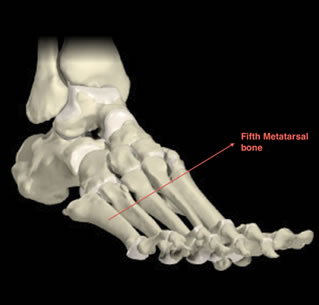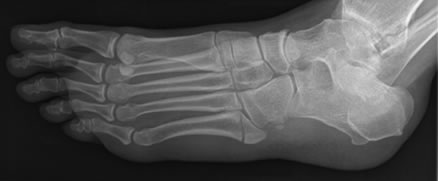in Foot and Ankle Surgery and Reconstruction

The foot has five metatarsal bones and the 5th is the one on the outside if the foot. There is a slight bump on the outside of the foot nearly halfway along the length of the foot, this is the base of the 5th metatarsal. The top end of the 5th metatarsal is just where the little toe starts. You can break the bone anywhere along it, but most commonly at its base.
Commonly caused by the foot twisting or rolling inwards similar to the way you can sprain your ankle, but can happen from the foot getting squashed or twisting other ways.
Pain usually fairly swiftly follows the injury but can be quite tolerable, in fact people can often walk with only a slight limp. The foot can swell up and bruise on the outside of the foot.
It is worth getting assessed with a few days of the injury to ensure that there is no other injury present such as a lateral ankle sprain or a Lisfranc injury. Clinical examination by an orthopaedic foot and ankle surgeon and X-Rays will be required.
An X-Ray of the foot will accurately diagnose the exact part of the bone that is injured.

The treatment depends on the exact fracture appearance on X-Ray. The vast majority are treated with a walking boot and crutches but in some particular fractures surgery may lead to a speedier recovery and return to sports if the patient so desires. This would be explained to you by an orthopaedic foot and ankle surgeon.
Following either operative or non-operative treatment full healing of the bone fracture is expected by 8-12 weeks. Activities and sports can be initiated shortly before then and a gradual return to full activity by 12-20 weeks depending on the activity and symptom level.
Over 90% will heal uneventfully and people return to full sports. In certain fractures a potential problem is “non-union”, where the bone doesn’t knit together properly and can continue to cause discomfort, stopping people from playing sports. If this happens then options to treat will be discussed with you and your surgeon, and may involve surgery to fix the fracture with a screw and possibly a very small amount of bone graft.